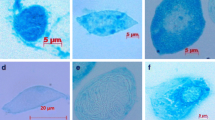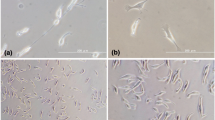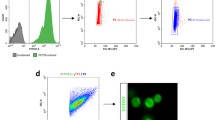Abstract
Primary cell cultures of immunocytes have been developed from the three psyllid species Cacopsylla melanoneura, Cacopsylla pyri (vectors of ‘Candidatus Phytoplasma mali’ and ‘Candidatus Phytoplasma pyri’, respectively) and Cacopsylla crataegi. The medium most suitable of those evaluated was Hert-Hunter 70 (HH70) psyllid medium. In fact, good survival and proliferation of the Cacopsylla immunocytes for over 60 d were observed, with mitosis activities starting at 15-d post culture. Moreover, adhesion and phagocytosis activities were confirmed for all the psyllid cell cultures by functionality tests. Morphological examination of cultured immunocytes revealed the presence of different cell types in all the three psyllid species in accordance to published data about insect immunocytes. The in vitro maintenance of psyllid immunocytes represents a powerful tool for a wide range of applications, especially for psyllid cell biology. In particular, in-depth studies on the biology of psyllids as vector insects as well as analyses to understand the mechanisms behind the interactions with pathogens and symbionts are now possible. These cultures can be used as an in vitro model to study psyllid humoral immune responses, which also will allow in-depth investigations on the abilities of psyllids as vectors of phytoplasmas. All these applications provide new opportunities to develop more focused and specific pest control strategies.



Similar content being viewed by others
References
Carraro L, Loi N, Ermacora P (2001) Transmission characteristic of the European stone fruit yellows phytoplasma and its vector Cacopsylla pruni. Eur J Plant Pathol 107:695–700
Carraro L, Loi N, Ermacora P, Gregoris A, Osler R (1998) Transmission of pear decline by using naturally infected Cacopsylla pyri. Acta Hort 472:665–668
Fallon AM, Sun D (2001) Exploration of mosquito immunity using cells in culture. Insect Biochem Mol Biol 31:263–278
Hodkinson ID (2009) Life cycle variation and adaptation in jumping plant lice (Insecta: Hemiptera: Psylloidea): a global synthesis. J Nat His 43:65–179
Hunter WB, Dowd SE, Katsar CS, Shatters RG, McKenzie CL, Hall DG (2009) Psyllid biology: expressed genes in adult Asian citrus psyllids, Diaphorina citri Kuwayama. The Open Entomology J 3:18–29
Jarausch B, Fuchs A, Schwind N, Krczal G, Jarausch W (2007) Cacopsylla picta as most important vector for ‘Candidatus Phytoplasma mali’ in Germany and neighbouring regions. Bull Insectol 60:189–190
Lavine MD, Strand MR (2002) Insect hemocytes and their role in immunity. Insect Biochem Mol Biol 32:1295–1309
Manfredini F, Dallai R, Ottaviani E (2008) Circulating hemocytes from larvae of the paper wasp Polistes dominulus (Hymenoptera, Vespidae). Tissue Cell 40:103–112
Marutani-Hert M, Hunter WB, Hall DG (2009) Establishment of Asian citrus psyllid (Diaphorina citri) primary cultures. In Vitro Cell Dev Biol-Animal 45:317–320
Mayer CJ, Jarausch B, Jarausch W, Jelkmann W, Vilcinskas A, Gross J (2009) Cacopsylla melanoneura has no relevance as vector of apple proliferation in Germany. Phytopathology 99:729–738
Pandey JP, Tiwari RK (2012) An overview of insect hemocyte science and its future application in applied and biomedical fields. Am J Biochem Mol Biol 2:82–105
Raddadi N, Gonella E, Camerota C, Pizzinat A, Tedeschi R, Crotti E, Mandrioli M, Bianco P, Daffonchio D, Alma A (2011) ‘Candidatus Liberibacter europaeus’ sp. nov. that is associated with and transmitted by the psyllid Cacopsylla pyri apparently behaves as an endophyte rather than a pathogen. Environ Micro 13:414–426
Smagghe G, Goodman CL, Stanley D (2009) Insect cell culture and applications in research and pest control management. In Vitro Cell Dev Biol-Animal 45:93–105
Su Q, Zhou X, Zhang Y (2013) Symbiont-mediated functions in insect hosts. Commun Integr Biol 6:e23804
Tedeschi R, Alma A (2004) Transmission of apple proliferation phytoplasma by Cacopsylla melanoneura (Homoptera: Psyllidae). J Econ Entomol 97:8–13
Tedeschi R, Lauterer P, Bertignono L, Alma A (2008) Hawthorn psyllid fauna in northwestern Italy. Bull Insectol 61:143–144
Author information
Authors and Affiliations
Corresponding author
Additional information
Editor: T. Okamoto
Rights and permissions
About this article
Cite this article
Monti, M., Mandrioli, M., Bextine, B. et al. Maintenance of primary cell cultures of immunocytes from Cacopsylla spp. psyllids: a new in vitro tool for the study of crop pest insects. In Vitro Cell.Dev.Biol.-Animal 50, 797–801 (2014). https://doi.org/10.1007/s11626-014-9785-7
Received:
Accepted:
Published:
Issue Date:
DOI: https://doi.org/10.1007/s11626-014-9785-7




